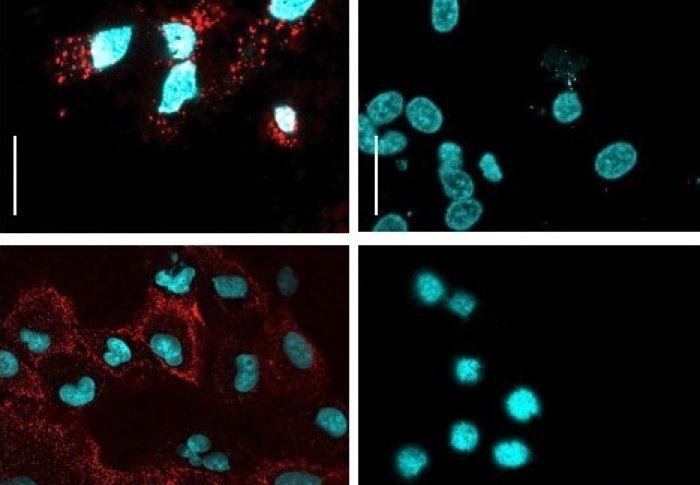Ovarian cancer cells switched off by 'unusual' mechanism
by Kate Wighton

Cancer cells (blue) are deactivated
Scientists at the Ovarian Cancer Action Research Centre at Imperial College London have discovered a mechanism that deactivates ovarian cancer cells.
The findings, published in EMBO Reports, could lead to better treatments for women with ovarian cancer.
The research has found a new mechanism for a protein named OPCML. This protein is known as a tumour suppressor, as it prevents cells turning cancerous.
These exciting results reveal potential new mechanisms by which we can attack ovarian cancer Professor Iain McNeish Director, Ovarian Cancer Action Research Centre
However OPCML is usually lost in cancer patients. Scientists have now found that when OPCML is put back into cancer cells, it cleverly deactivates a type of protein called AXL.
Previous research has shown the AXL protein accelerates the growth and spread of ovarian cancer cells. Clinical trials are already underway for treatments that block AXL, called AXL inhibitors.
But this new early stage research demonstrates potential for minimising treatment with AXL inhibitors, and in turn reducing side effects for women being treated for ovarian cancer.
When AXL becomes activated, it renders cancer cells more aggressive, increasing their ability to move and spread to other parts of the body.
However, it also reveals itself to OPCML, which then drags the bound molecules into a specific region of the cell where AXL is deactivated.

The research was funded by medical research charity Ovarian Cancer Action and carried out at the Ovarian Cancer Action Research Centre at Imperial College London.
The study, co-authored by Dr Chiara Recchi and Professor Hani Gabra, found that since OPCML already blocks most of AXL, much less AXL inhibitor is required to deactivate the ovarian cancer cells.
Since inhibitors always present a certain degree of toxicity, if the dose of the inhibitor could be reduced, the patients should suffer fewer side effects.
The next stage is to develop OPCML as a therapeutic agent.
Since OPCML acts on the external part of the cells, delivering it on the surface of cancer cells could represent an efficient therapeutic strategy.
Also, OPCML is a “natural” protein present in most of the cells of our bodies, so it should have minimal toxicity.
New treatments
Dr Chiara Recchi, lead author of the study from the Department of Surgery and Cancer at Imperial, said: “Our results are really exciting because they reveal an unusual biological mechanism and shed light on the function of AXL, pointing us in the right direction to find a way to switch it off in cancer patients. In this context, OPCML has a tremendous potential as therapeutic.”
Dr Jane Antony, Research Associate and first author of the study said: “This study will enable new treatment strategies to be designed to fight recurrent and aggressive ovarian cancer, for which there are currently limited treatment options. AXL has always been a key player in cancer metastasis and these results reveal how these cancer drivers can be modulated by tumour suppressors such as OPCML.”
Professor Iain McNeish, Director of Ovarian Cancer Action Research Centre at Imperial, said: “At the Ovarian Cancer Action Research Centre, our aim is always to translate important scientific discoveries into new treatments for our patients. These exciting results reveal potential new mechanisms by which we can attack ovarian cancer.”
-
'The tumour suppressor OPCML promotes AXL inactivation by the phosphatase PTPRG in ovarian cancer' by J. Antony et al. is published in EMBO Reports. DOI 10.15252/embr.201745670
Article text (excluding photos or graphics) © Imperial College London.
Photos and graphics subject to third party copyright used with permission or © Imperial College London.
Reporter
Kate Wighton
Communications Division